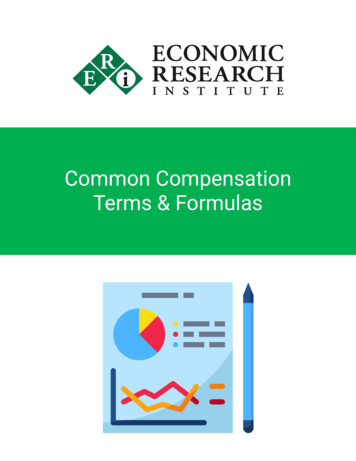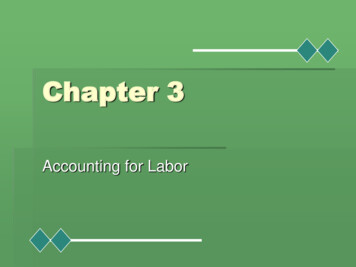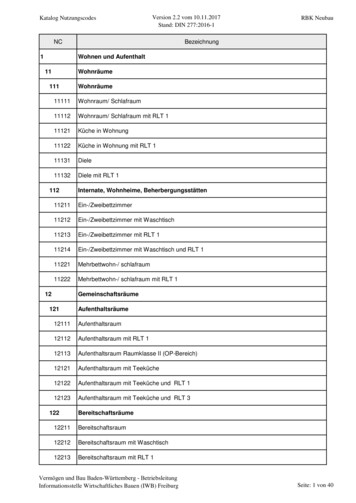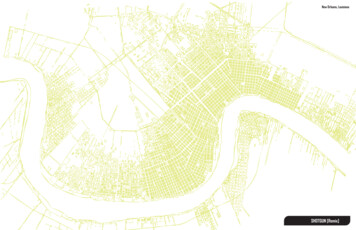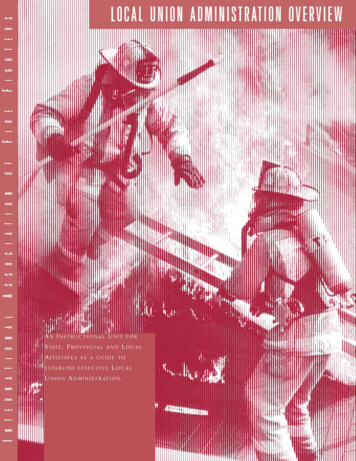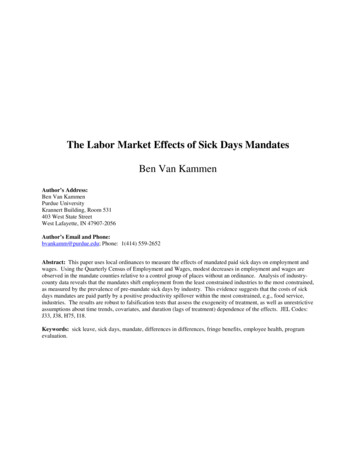
Transcription
The Labor Market Effects of Sick Days MandatesBen Van KammenAuthor’s Address:Ben Van KammenPurdue UniversityKrannert Building, Room 531403 West State StreetWest Lafayette, IN 47907-2056Author’s Email and Phone:bvankamm@purdue.edu; Phone: 1(414) 559-2652Abstract: This paper uses local ordinances to measure the effects of mandated paid sick days on employment andwages. Using the Quarterly Census of Employment and Wages, modest decreases in employment and wages areobserved in the mandate counties relative to a control group of places without an ordinance. Analysis of industrycounty data reveals that the mandates shift employment from the least constrained industries to the most constrained,as measured by the prevalence of pre-mandate sick days by industry. This evidence suggests that the costs of sickdays mandates are paid partly by a positive productivity spillover within the most constrained, e.g., food service,industries. The results are robust to falsification tests that assess the exogeneity of treatment, as well as unrestrictiveassumptions about time trends, covariates, and duration (lags of treatment) dependence of the effects. JEL Codes:J33, J38, H75, I18.Keywords: sick leave, sick days, mandate, differences in differences, fringe benefits, employee health, programevaluation.
11. INTRODUCTIONThe most convincing argument in favor of paid sick days mandates asserts that theycorrect a negative public health externality by encouraging contagiously ill workers to quarantinethemselves at home. These merits have motivated most nations, i.e., at least 145 (Heymann2007), to mandate that some paid sick days be part of employees’ compensation. The UnitedStates has not, presumably judging that employers would offer paid sick days voluntarily in lieuof other compensation to any employees that want them.Along with other job amenities, paid sick time is a non-wage employment benefittransacted in an implicit market. Equilibrium in this market could exhibit the optimal incidenceof sick time provision, in which case mandating a different level would likely harm employment.Alternatively firms may under-provide sick time if it has un-internalized spillover benefits. It isuncontroversial that co-workers contribute to good health in their workplaces when they stayhome with contagious illnesses. Firms’ interests are aligned with limiting the spread of illnessesand internalizing their productivity effects on co-workers, thus paying sick workers to stay homeis part of maximizing employers’ profits. Since firms have no incentive to internalize spilloversto other firms’ employees, though, under-provision of paid leave follows if health externalitiesextend beyond co-workers at the same firm.Government mandates in other countries, and an increasing number of states andmunicipalities in the United States, reveal concerns that the prevalence of paid sick days is suboptimal. If these mandates correct a market failure, external productivity gains couldcompensate for the burden of compliance and increase employment at the constrained firms.This paper measures the employment and wage effects of local paid sick days mandatesby employing a differences in differences (hereafter DD) strategy. Many researchers [e.g., Card
2and Krueger (1994), Klerman and Leibowitz (1997) and Ruhm (1998), Baker and Milligan(2008)] have used DD to analyze similar policies. I compare the outcomes in U.S. localities thathave enacted laws mandating paid sick days to places that did not do so. My estimates indicatesmall negative effects of sick days mandates, less than 1 percent, on both county-levelemployment and wages. Analysis of industries within each county, however, revealsheterogeneity on the basis of how constrained each industry was by the law. The laws shiftedemployment from industries with relatively high pre-mandate sick days prevalence to industrieswith relatively low sick days prevalence. Though I do not reject the null of zero effect on theindustries’ wages, the estimates suggest wages decreased in the most constrained industries, inabsolute terms and relative to the least constrained industries. For the latter group, the pointestimates indicate a positive wage effect.Employment increases in the constrained industries indicate that mandated paid sick dayslaws, indeed, correct a market failure. Advocates of the mandates sometimes tout them as a wayof relieving employees from choosing between health and income, however, employees do payfor mandated sick days with lower wages. Sick days mandates fail to pull more people into thelabor market on net, since employment gains in constrained industries are offset by losses in lessconstrained industries. Functionally the sick days mandate is like a subsidy to the industries thatdidn’t already give employees sick days.Section 2 of this paper summarizes the preceding literature on benefits mandates andespouses the theoretical effects of mandating employee benefits. Section 3 describes the dataand methods I use to measure the effects of mandates. Section 4 conveys the results of themethods used, and section 5 summarizes the conclusions drawn from those results. Though
3some international statues make a distinction between the terms based on the length of theabsence, throughout the paper I use “paid sick days” and “paid sick leave” interchangeably.2. BACKGROUND, LITERATURE REVIEW, AND DISCUSSION OF THEORYA municipality may pass a law, through a referendum for example, requiring privateemployers to provide sick days to their employees at a specific rate, i.e., paid hours per hoursworked, and subject to a maximum number of sick days. The timeline (figure 1) showsexamples of such laws, and an overview of their provisions is on table 1.{Place table 1 about here}The places that legislate and enforce mandates are the treatment group in this analysis.San Francisco passed the first law of this kind in 2006, and it took effect in February of 2007.Washington, D.C., introduced a law shortly after that, passed it, and implemented it in Novemberof 2008. Milwaukee passed a sick days mandate in a referendum but it was subsequentlyoverturned by the State of Wisconsin. Popularity has increased since 2012 with the State ofConnecticut, Seattle, Portland (OR), New York City, and several cities in New Jersey enactingmandates. California and Oregon will enact statewide mandates in 2015, and a handful of localmandates will be enacted in the near future (National Partnership for Women and Families), butsome time must elapse before their effects can be observed. Additionally the Federalgovernment (the Healthy Families Act) and 25 states have bills proposing mandated sick days(ibid).{Place figure 1 about here}Consider what to expect when measuring these laws’ effects on labor employment andwages. The key theoretical forebear of this topic is Summers’s (1989) “Simple Economics of
4Mandated Benefits,” which allows for three possible effects on employment. First if employeesvalue a mandated benefit equal to its cost, employees will effectively pay for it by acceptingreduced wages at the identical level of employment. Second mandating a worthless benefit hasthe same effect as a tax on labor: shifting labor demand downward by the cost of the benefitwithout an off-setting shift in supply. A final possibility is mandating a benefit that is morevaluable to employees than it costs, which increases employment. If this is observed, it’sincumbent on the observer to explain why the mandate was necessary, considering that it revealsunmade mutually beneficial trades between employers and employees.As noted by Summers (178) using the example of health insurance, this may occur ifemployees’ good health has externalities that firms have no interest in resolving. As with astandard positive externality, paid sick time is under-provided if its good health benefits spillover to employees at different firms. Then correcting the externality attracts people, i.e., those atthe margin in terms of their preferred mix of wage and benefits, to the constrained firms fromother jobs or from outside the labor force. If the mandated level of sick leave is chosen wisely,this explains why a positive employment effect is foreseeable.Adverse selection could further explain the under-provision of sick days. Specifically amandate can have net positive effect on labor markets if it corrects an information asymmetry, asproposed by Aghion and Hermalin (1990). Perhaps firms expect that offering sick days willattract unusually sickly applicants. But if all employers must offer sick days by law, the sicklypopulation diffuses among employers according to mutual benefit instead of pooling by the onesthat offer leave voluntarily. In this manner, a sick days mandate “destroys the choice” as well asthe market failure.
5Predictions about the effect of a benefits mandate can be extended to particular firmswithin a geographical market. For example disemployment is more likely if employees cannotpay for the mandated benefit because of a minimum wage. Marks (2011) and Simon andKaestner (2004) analyze the effects of minimum wage increases on provision of fringe benefits,hypothesizing that they could be a buffer against disemployment; the reverse of this processcould occur with mandated benefits. More directly the effect of the mandate should differbetween industries that already give most employees paid leave, i.e., where the law is looselybinding, and those that don’t. Although I do not use the information on average firm size in theQCEW in this paper, the laws are explicitly less binding on smaller firms. The variation across 2digit industries in average firm size is coarser than desired for showing differential effects.Following the health insurance example in Summers, three forces could contribute to theeffect of a sick days mandate: the cost of complying with it, the value of sick days to employeesthat get them as a result of the mandate, and the positive health externality. Markets without premandate sick days provision would potentially experience all three; markets with sick leavealready would experience only the externality. This predicts that industries with abundant paidsick leave prior to the mandate move up the supply curve as a result of the law and experiencehigher wages and productivity. Employment in such a market would also increase unlessapplicants were pulled away toward the more constrained markets. Markets without premandate paid sick leave could experience employment and wage increases or decreasesdepending on the magnitudes of the three forces. Namely the externality and employees’valuation of sick days tend to increase employment; the cost of compliance tends to decreaseemployment; the cost and valuation tend to decrease wages, and the externality tends to increasewages.
6Measuring these effects is more complicated than reading a labor supply and demandgraph, though. Mitchell (1990) suggests the possibility of substituting mandated benefits forother benefits, rather than wages. Her paper additionally contains a useful summary of previousestimation techniques for measuring wage-benefit substitutability. Mitchell also recognizes thata mandate affects the relative prices of labor in addition to the input price level that firms face.Low-skilled workers are more likely to be affected by a benefits mandate because they are lesslikely to receive fringe benefits voluntarily. Requiring employers to provide benefits to allemployees does nothing for the employees that already receive said benefits but increases thecosts of employing low-skilled workers. So substitution among types of workers (away fromlow-skilled) might mitigate a mandate’s disemployment effect. More on the wage-benefitsubstitution mechanism can be found in Woodbury (1983), Feldman (1993), Simon (2001),Olson (2002), or Marks (2011). Studies on more specific groups like low-wage workers (Leeand Warren 1999; Sherstyuk, Wachsman, and Russo 2007), and teens (Kaestner 1996) are alsoavailable, and the most common mandated benefit they examine is health insurance.Some research has been performed on measuring the cost improving worker healthdirectly. Markussen (2011) studied Norwegian individuals using matched employee-physiciandata and instrumental variables methods, finding that spells of sick leave have a negativerelationship with lagged measures of earnings. Another of his papers (2010) endeavors touncover the optimal wage replacement rate for employees on sick leave. This is not interpretedas an estimate of sick leave’s compensating wage differential, though, since Norwegian workershave social insurance that provides 52 weeks of paid leave. Instead sick leave’s wage effects areinterpreted as depreciated human capital and signals of productivity. A survey of the value ofsick days can be found in Earle and Heymann (2006). One quantitative estimate of
7“presenteeism” costs, lost productivity when workers are sick at work, comes from Goetzel, et al.(2004). Some of the authors’ larger estimates suggest that on a per worker-year basis, illnessesresult in 100 to 400 of lost productivity. But many conditions studied in that paper are chronicillnesses that are unlikely to improve with a sick leave allowance. Lovell (2004) focuses on thepublic health benefit instead of productivity, but a precise estimate (measured in GDP or workerdays) of the value is absent. Even if the mandate harmed labor market efficiency, the publichealth benefits are potentially great enough to offset those costs and make it a beneficial policy.As evidence that the San Francisco law improved public health, my findings are preceded byDrago and Lovell (2011) who, in employee surveys, found reductions in the prevalence of sickworkers and of sick children attending school.In terms of methods and subject, the five papers that are most similar to this one are:Ruhm’s (1998) study of parental leave mandates in European countries, Klerman andLeibowitz’s (1997) study of maternity leave mandates in 12 American states between 1987 and1993, Ziebarth and Karlsson’s (2010) study of changes to sick leave mandates in Germanyduring 1996-97, Colla, Dow, and Dube’s (forthcoming) evaluation of the San Francisco HealthCare Security Ordinance, and Petro’s (2010) case study of the San Francisco sick daysordinance.The first two papers rely on DD as well as DDD since they also exploit differencesbetween males’ and females’ uses of parental leave (Ruhm) and between new mothers andmothers of older children (Klerman and Leibowitz) to measure the policies’ effects. Petro does aless formal version of this, focusing on small firms and the retail and food service industries. Allfour papers use DD methods in which a group is treated with a change to its mandated level ofleave, and that group is compared to another that is untreated.
8Ziebarth and Karlsson emphasize labor costs more than employment levels and findsignificant decreases in the utilization of sick days under the less generous mandate. Ruhm’sresults indicate that mandated parental leave increases female employment-population ratio by1.3 to 1.8 percentage points. Klerman and Leibowitz conclude that maternal leave statutes havea negligible effect on female employment. Petro’s conclusion is that employment grewrelatively rapidly in San Francisco county compared to five neighboring counties, and that thegrowth rate of business establishments (large and small) in San Francisco outpaced neighboringcounties during the period following the mandate.Colla, Dow and Dube study a “pay or play” health insurance mandate enacted in SanFrancisco in 2008. Though it did not coincide with the paid sick days mandate, the timing isnear enough that controlling for its effects in this paper is important. Moreover CDD use thesame data source for their paper that I use and find similar effects associated with SanFrancisco’s Health Care Security Ordinance, i.e., small and probably negative effects onemployment and wages.3. METHODS AND DATAA. County AnalysisI use panel data to estimate the following model:𝑌𝑌𝑖𝑖𝑖𝑖 𝛼𝛼𝑖𝑖 𝛼𝛼𝑡𝑡 𝑠𝑠 𝛽𝛽𝑠𝑠 �𝑡 𝑠𝑠 𝛾𝛾𝑖𝑖 𝑡𝑡 𝛿𝛿 ′ 𝑋𝑋𝑖𝑖𝑖𝑖 𝜙𝜙𝑌𝑌𝑖𝑖,𝑡𝑡 1 𝜀𝜀𝑖𝑖𝑖𝑖 ,(1)where, i indexes counties, and s and t index months. Y is the natural logarithm of employment.In the subsequent regression measuring the wage effect, Y is the log average weekly real wage. I
9include county and time fixed effects, represented by α𝑖𝑖 and α𝑡𝑡 , and idiosyncratic time trends, 𝛾𝛾𝑖𝑖 .X is a vector of control variables: log of county population, logs of federal, state, and localgovernment employment, minimum wage, and population growth variables. Minimum wage isobserved for the state in which county i is located and in the year of which month t is part. SanFrancisco has (and a few other counties near the end of the sample have) a higher local minimumwage and differs from the rest of the state. Since San Francisco enacted its health insurancemandate (Colla, Dow, Dube) at approximately the same time as its sick leave mandate, I controlfor the dollar value per hour of mandated health insurance contributions and try not to confoundthe two laws’ effects. SICKMANDATE is an indicator for whether a mandate has been enacted;𝛽𝛽 is the effect of the mandate. The sum of coefficients (including lags) estimates how theemployment effect accumulates as time passes. 1I assume and verify with a test that the mandate indicator is strictly exogenous in (1), i.e.,after conditioning on the fixed effects, time trends, and (instrumented) autoregressive term. Theleads of the mandate indicator are the basis for a falsification test described by Rothstein (2010)and Koedel and Betts (2011). If leads of the treatment indicator are not excludable in theestimates, it is a signal that the exogeneity assumption fails. In addition to performing this on allspecifications, I test restrictions on the coefficients in (1): restricting the treatment effect tobeing independent (𝛽𝛽𝑠𝑠 𝛽𝛽 𝑠𝑠) of time elapsed since the law’s enactment, restricting theautocorrelation in Y (𝜙𝜙 0), and restricting the treatment and control counties to havingcommon time trends. No mandate has been repealed so far, so the SICK indicators stay on onceturned on and I cannot compare switching on to switching off effects.1This methodology follows McCrary (2007), particularly for the interpretation of coefficients. Also see Wolfers(2006), Jacobson, Lalonde and Sullivan (1993).
10Estimates of 𝛽𝛽, however, are not qualitatively sensitive to stronger assumptions outlinedabove, e.g., about autoregression in employment or wages. An addition to the robustness of theestimates is that the residuals are clustered when computing the standard errors, a techniqueproposed by Arellano (1987). This addresses the effects of arbitrary correlation amongobservations of the same place. All the standard errors presented from estimates of employmentand wage in this paper are of the cluster (by county or by industry-county where applicable)robust variety.B. Industry AnalysisTo reinforce the county estimates, I estimate a model at the industry-county level. Thisenables me to interact the treatment variables with measures of each industry’s proportion ofworkers affected by the mandate. Specifically I estimate the following:𝑌𝑌𝑖𝑖𝑖𝑖𝑖𝑖 𝛼𝛼𝑖𝑖𝑖𝑖 𝛼𝛼𝑡𝑡 𝑠𝑠 𝛽𝛽1𝑠𝑠 𝛽𝛽2𝑠𝑠 𝑉𝑉𝑉𝑉𝐿𝐿𝑗𝑗 𝑖 𝑠𝑠 𝛾𝛾𝑖𝑖𝑖𝑖 𝑡𝑡 𝛿𝛿 ′ 𝑋𝑋𝑖𝑖𝑖𝑖 𝜙𝜙𝑌𝑌𝑖𝑖𝑖𝑖,𝑡𝑡 1 𝜀𝜀𝑖𝑖𝑖𝑖𝑖𝑖 . (2)Y is the log of employment (subsequently of average wage) in industry “j” in county “i” inmonth “t”. The mandate indicator is defined as before, but in this equation it is interacted withthe industry characteristic “𝑉𝑉𝑉𝑉𝐿𝐿𝑗𝑗 ,” proportion of workers in that industry that already transactedpaid sick days from their employers voluntarily.{{Place Table 2 about here}}Following estimation of the duration-independent version of (2), I contrast the effects onthe minimally constrained 𝛽𝛽̂1 𝛽𝛽̂2 0.93 and maximally constrained 𝛽𝛽̂1 𝛽𝛽̂2 0.27 industries as an illustration of how the effect varies depending on initial conditions. Utilities is
11the industry with 93% voluntary sick days, and Accommodation and Food Services has 27%.Within the treatment counties, industries with near-universal sick days should experience nowage-fringe trade as a result of the mandate, but they could get positive (productivity-enhancing)health externalities. An industry with low prevalence of sick days would also experience thehealth externality (if anything, even more intensely) and a wage-fringe trade. If the healthexternality makes the mandated sick days “cheap” for workers, though, the most constrainedindustries become more attractive, relative to the minimally constrained ones, in terms of wagefringe combinations. Thus employment may shift from the least constrained industries to themost constrained, within the mandate counties.C. DataData on employment and wages are available from the QCEW, compiled by the Bureauof Labor Statistics. The QCEW contains the employment in each county, disaggregated byNAICS industry. Employment is observed on a monthly basis, so the data set consists of monthcounty observations. Average weekly wage per county is observed each quarter and can also betabulated by industry. In addition, the QCEW reports the number of government employees(local, state, and Federal separately) in each county. Other sources of data for the main estimatescome from the U.S. Census (county birth, domestic and international migration rates) and theDepartment of Labor (minimum wage by state and year). National Compensation Survey (NCS,March 2010) tables provide statistics on the prevalence of paid sick days by industry, using theNAICS 2 digit classification.{{Place Table 3 about here}}
12As the time span for the sample, I use 2003 to 2014 inclusive. San Francisco’s mandatewas proposed in August 2006 and passed in November 2006, so a substantial number of periodsare observed to establish a pre-treatment trend and use leads of the mandate indicator. The mostrecent mandate in the sample is Newark, NJ in May 2014, so the treatment lags are limited to 7months if all 19 counties are to be used to measure their effects.Aside from the variables already mentioned, time trends have autonomous effects onemployment. All of the economic variables discussed are time-variant; business cycles, nationalpopulation growth, globalization, et al., affect them, and the trends can differ across locations.To capture additional variation over time that might confound the interpretation of the estimates,I include month (quarter for the wage regressions) by year indicators and two varieties of timetrends (alternately): treatment-specific and county-specific [industry-county-specific for (2)]. Inboth models, 𝛼𝛼𝑡𝑡 and 𝛾𝛾 capture these influences.4. ESTIMATION RESULTSA. Main ResultsIt’s probable that a small decrease in employment accompanies paid sick days mandatesand has a magnitude of less than ½ percent. This comes from the most precise of the estimateson table 4 that pass the falsification test, i.e., column 4. This specification is model (1), with arestriction on the lagged effects of the treatment. Using this estimate, it’s possible to sign theeffect with only a little over 90% confidence, though. The other estimates are same-signed andsimilar in magnitude but with less precision.{{Place Table 4 about here}}
13Lagged employment seems to be the decisive covariate in passing the falsification test,based on the excludability of 8 leads of the treatment indicator. Adding controls for populationgrowth and other labor market policies neither improves nor harms (columns 2 and 4) theperformance on the test compared to conditioning only on lagged employment (andinstrumenting using the 2nd and 3rd lags). Nor does relaxing restrictions on the time trends(column 6) have much effect on the falsification test.Comparing this to the Petro (2010) finding, his results indicate that San FranciscoCounty’s employment increased 4.7% during the same period and that employment in the fivecounties surrounding San Francisco decreased 2.5%. Petro’s finding is that employment growthin San Francisco was 7.2 percentage points higher than neighboring counties, but the failure toaccount for both population growth and time trends limits what can be causally attributable to thesick days policy. When I estimate (1) using only California counties, I estimate the causal effectof San Francisco’s paid sick days mandate is a ¾ point decrease. The estimate is noisy, but theupper bound of the confidence interval is a 1 point increase, whereas the lower bound is a 2.5%decrease. The causal effect of a paid sick days mandate on county employment is much smallerand possibly opposite in sign from the earlier estimate.My point estimates of the effect on county average wage are consistent with employeespaying for mandated paid sick days with lower wages. The specifications that pass thefalsification test indicate a decrease in wages between two-thirds of a point and a full point(columns 1, 2, and 6). They are, however, even less precise than the employment effects andimpossible to sign with high confidence.{{Place Table 5 about here}}
14The negative effect on county wages could be as large as 2 percentage points, and mydata could be failing to measure it accurately enough. The null hypothesized zero effect is wellwithin the confidence interval, though, and I conclude that the effect on wages is practicallysmall regardless of its sign. This challenges the prediction that employees pay for mandatedbenefits that are valuable. Specifically it suggests the mandates have a positive productivityeffect that offsets part of, maybe even most of, the cost of complying with them.{{Place figure 2 about here}}Combining the two results, a small negative effect on employment and a small(indeterminate sign) effect on wages, the mandated benefits theory holds but with somethingpushing the wage back up the supply curve. Given the nature of the law, I would label this ahealth externality. Focusing on industries within mandate counties clarifies the basis for thisconclusion, and I now present the different effects across the 18 two digit industries that differwith respect to pre-mandate sick days provision.B. Industry AnalysisIn model (2), I distinguish among industries according to the fraction of their workersthat receives paid sick days voluntarily and interact this (𝑉𝑉𝑉𝑉𝐿𝐿𝑗𝑗 ) variable with the treatmentindicator. 2 The employment results on table 6 and wage results on table 7 reveal more labormarket activity within counties than is apparent from the preceding tables. I reach thisconclusion from estimating the coefficients 𝛽𝛽1and 𝛽𝛽2 in the industry equation with 𝛽𝛽1representing the effect on an (hypothetical) industry with no pre-mandate paid sick days, and𝛽𝛽1 𝛽𝛽2 , representing the effect on an industry with universal pre-mandate paid sick days. SinceThe full interaction is not identified since 𝑉𝑉𝑉𝑉𝐿𝐿𝑗𝑗 is temporally invariant in my data. Only cross-sectional variationin the 2010 NCS is used.2
15no industry has such extreme values for 𝑉𝑉𝑉𝑉𝐿𝐿𝑗𝑗 , I report the effects for the minimum andmaximum industries in the data. The samples, covariates, adjustments to standard errors(clustered on industry-county), and dependent variables (logs of employment and wages, now atthe 2 digit industry level) are the same as previously.{{Place Table 6 about here}}The employment effect is the most interesting finding. Though the county average effectis small and negative, it is not uniform across industries. Particularly the mandate shiftsemployment from the minimally constrained industries to the more constrained (think “fastfood”) industries. For these opposing effects, I reject the null in almost every specification.Columns 2 and 5, the specifications that pass the falsification test, indicate a 0.5% to 2% increasein the most constrained industries and a comparable magnitude decrease in employment in theleast constrained industries. The other estimates confirm the signs of the employment changesbut exaggerate their sizes (columns 1, 3, 4, 7 and 8). Once again controlling and instrumentingfor lagged employment is important to avoid overstating the effects of the mandates.Turning to the effect on wages, again there is evidence that the effect differs according tothe prevalence of pre-mandate sick days in the industry. This time the effect favors the leastconstrained, as expected since they bear less costs of compliance. While I can say with highconfidence, based on columns 1, 3, and 4, that there is a difference between the minimally andmaximally constrained industries, putting them on opposite sides of zero is just out of reach. Allof the confidence intervals include zero. But for the Food and Accommodation Servicesindustry, zero is very close to the upper bound in most specifications, for the Utilities industryzero is very close to the lower bound.{{Place Table 7 about here}}
16The averaging of these effects over the county accounts for the small county wage effectson table 5, but the average again masks within county wage changes. I conclude that the mostlikely outcome is a less than 2% wage decrease in Food and Accommodation’s wages and a lessthan 2% wage increase in Utilities (and other similar) industry wages. Putting together theemployment and wage results, paid sick days mandates decrease employment and increasewages in industries that already have a lot of paid sick days, and they increase employment anddecrease wages in industries that do not have a lot of paid sick days.C. Robustness ChecksThe results are not qualitatively sensitive to the specificity of time trends or the inclusionof time varying controls, including other policy variables like the minimum wage. Theemployment results rely on controlling and instrumenting for lagged employment, but the wageresults do not. Allowing the treatment eff
Ben Van Kammen . Author's Address: Ben Van Kammen . Purdue University . Krannert Building, Room 531 . 403 West State Street . West Lafayette, IN 47907-2056 . Author's Email and Phone: bvankamm@purdue.edu; Phone: 1(414) 559-2652. Abstract: This paper uses local ordinances to measure the effects of mandated paid sick days on employment and wages.





